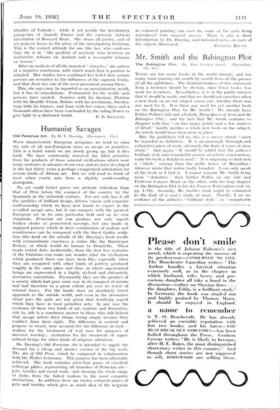Humanist Savages
Old Peruvian Art. By H. V. Doering. (Zweinmer. 15s.) WiTu characteristic European arrogance we tend to class the arts of all non-European races as savage or primitive. This is a habit which we are slowly giving up, but it dies hard. We have courteously removed the label primitive from the products of those oriental civilisations which were many centuries in advance of our own, and we have developed in the last thirty years a perhaps exaggerated admiration for certain kinds of African art. But we still tend to think of most other exotic arts from a slightly condescending standpoint.
No art could better prove our attitude ridiculous than that of Peru before the conquest of the country by the Spaniards in the sixteenth century. For not only has it all the qualities of brilliant design, intense vigour and exquisite craftsmanship which we have now learnt to expect in the so-Called savage arts, but it can compete with the greatest European art in its own particular field and on its own standards. Peruvian art can produce not only superb feather cloaks or geometrical carvings, but also heads in unglazed pottery which in their combination of realism and sensitiveness can be compared with the finest Gothic sculp- ture (the head on the outside of Dr. Doering's book recalls with extraordinary exactness a statue like the Bomberger Reiter), or which would do honour to Donatello. These heads (which date, incidentally, from the first five centuries of the Christian era) make one wonder what the civilisation which produced them can have been like, especially when they are compared with other kinds of pottery produced roughly in the same place and time, in which supernatural beings are represented in a highly stylised and elaborately decorative convention. Presumably they arc the product of a society which had gone some way in its conquest of nature and- had therefore to a great extent got over its terror of natural forces. For the heads show an absolutely direct approach to the outside world, and even in the decorative ritual pots the gods are not given that terrifying aspect which they have in most primitive arts. In any case the existence of these two kinds of art, realistic and decorative, side by side is a conclusive answer to those who still believe that savage artists drew things wrong simply because they couldn't draw them right. The difference in content and purpose so clearly here accounts for the difference in style— realism for the treatment of real men for purposes of ancestor worship ; stylisation for the treatment of super- natural beings for other kinds of religious adoration.
Dr. Doering's Old Peruvian Art is intended to supply the demand for a cheap and shorter version of the big work, The Art of Old Peru, which he composed in collaboration with Dr. Walter Lehmann. This purpose has been admirably achieved. The book contains sixty-four pages of excellent collotype plates, representing all branches of Peruvian art— rots, textiles and metal work—and showing the whole range of styles from the fullest realism to the most complete abstraction. In addition there are twelve coloured plates of Pots and textiles *which give as much ick a of the originals as coloured printing can ever do, some of the pots being reproduced with unusual success. There is also a short introduction by 1)r. Doering, and historical notus on each of










































 Previous page
Previous page